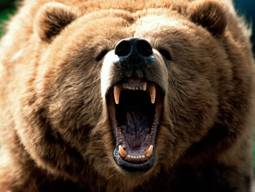And finally…

Bear necessities - starving predators turn on Platinum miners in Kamchatka, reports Ted Nield.
I once asked a geologist (Prof. Keith Oles of Oregon State University), who had then just finished mapping work on the Alaskan North Slope and the mountains behind, why, in all his pictures, did the geologists appear to be packing heat. “Ah – the six-shooters” he said. “Yup. You carry them just in case you should come around a bluff and surprise a grizzly. Then you can at least commit suicide.”
This seems not to have been an option for workers in Kamchatka recently, the remote and fly-infested volcanic wilderness on Russia’s Pacific seaboard, where (reports say) up to 30 bears have attacked and eaten two men and trapped a group of geologists in a camp owned and operated by a platinum mining company.
Russian agencies reported that the bears, who were apparently starving, killed the two security guards on Thursday 24 July. However, following the attack, about 400 geologists and miners refused to return to work. Agencies reported that attempts to shoot the bears had been foiled by bad weather.
Kamchatka boasts the largest Eurasian bear population in the world - around 12,000 beasts; but the predators have recently been faced with competition for salmon, their natural food source, which has driven them into cities and – in this case – to eating humans. Poaching with nets has indeed led to a dramatic decline in Pacific salmon, which has already cleaned out “entire species” in some rivers, according to environmentalists. Officials believe that 100,000 tonnes of salmon are being illegally fished in Kamchatka each year. They also say that last year, hunters shot at least 300 bears, while another 600 were killed illegally.
Laura Williams, director of WWF's Kamchatka office, speaking from Moscow, was quoted in the UK newspaper The Guardian as saying: "It's always the bears’ fault”. This of course is easier to say if you’re not the one being charged while fumbling for a revolver in order to commit suicide. Meanwhile, Itar-Tass agency reported that a team of hunters would be dispatched to shoot “or chase off” the bears.